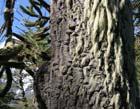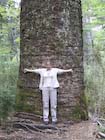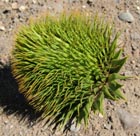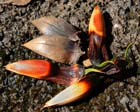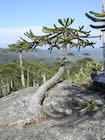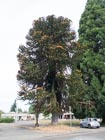Conservation Status

Araucaria araucana
(Molina) K.Koch 1873
Common names
Pehuén [Spanish, from Mapuche]; piñonero, pino araucaria, araucaria de Neuquén, pino de Neuquén, chihuén, pino hachado, pino solo [Spanish]; Araucaria, Chilean pine, monkeypuzzle tree [English]; Araucaria du Chili [French]; pino del Paranà [Italian]; apeboom [Dutch]; andentanne, Chile-Tanne, Chilenische Araukarie [German]; Andesi délfenyo, Csilei araukária [Hungarian]; араукария чилийская [Russian]; 智利南洋杉 (zhi li nan yang shan) [Chinese] (Farjon et al. 2014).
Taxonomic notes
Synonymy:
- Pinus araucana Molina 1782
- Dombeya chilensis Lam. 1786
- Araucaria imbricata Pav. 1797
- Abies araucana (Molina) Poir. 1805
- Columbea quadrifaria Salisb. 1807
- Araucaria dombeyi A. Rich. 1822
- Columbea imbricata (Pav.) Carrière 1867
Description
Evergreen, (mostly) dioecious trees to 40 m tall and 150 cm dbh. Bark gray-brown, resinous, smooth, marked by rings made by old branch scars. Branches horizontal, whorled, lateral branches horizontal or slightly pendant. Leaves scale-like, persistent on the trunk for many years, ovate-lanceolate, shiny green on both surfaces, 30-50 × 8-25 mm, surface marked with longitudinal lines, with stomata on both faces, persisting 10-15 years. Male cones solitary or in groups, erect, yellowish-brown, 7-15 cm long by 5 cm wide, with 20 whorled scales; microsporophylls acute, recurved. Female cone globular, dark brown, maturing in 2-3 years, 10-18 cm. long by 8-15 cm. wide, falling off at maturity, scales with a long triangular recurved point. Seeds bright brown to orangish, triangular, 2.5-4 cm. long by 0.7-1.5 cm. wide, with a long narrow nut, with 2 small even wings at the top, margins denticulate at the apex (Silba 1986, and my pers. obs.). See García Esteban et al. (2004) for a detailed characterization of the wood anatomy.
Distribution and Ecology
S Chile and SW Argentina. In Chile it occurs in the Andes at 37-40°S and the Cordillera de Nahuelbuta at 37-38°S, and in Argentina it is found in the Andes at 38-39°S. It grows in both mixed (deciduous or evergreen) forests and in pure stands. It is a highly fire-adapted species, occurring in an area where fires have long been caused by volcanic activity and, since the early Holocene, by humans. It occurs in both primary and secondary succession, establishing in burned rocky areas as well as under postfire stands of Nothofagus spp. (Global Trees Campaign [no date]).
Abstract of Burns (1993): "The emergent conifer Araucaria araucana (Mol.) K. Koch and the small deciduous broadleaved tree Nothofagus antarctica (Forst.) Oerst. occur as mixed post-fire stands in south-central Chile and Argentina. Both species are adapted to survive fire. Adaptations of A. araucana include thick bark, sprouting from epicormic buds and protected terminal buds on branches. N. antarctica resprouts vigorously after fire with multiple shoots. This study investigated the dynamics of this community, particularly in relation to fire. Recently burnt stands were examined for size-related response to fire. All A. araucana < 30 cm d.b.h. were killed with larger trees surviving. The size of these surviving A. araucana is probably related to fire intensity. Stand disturbance histories, population size and age distributions, diameter growth rate patterns and spatial relationships of different size classes, within and between species, were examined in intact stands. Most of these stands contained evidence of past fire. Within the first decade after fire, A. araucana (but not N. antarctica) seedlings or root suckers began to establish beneath the resprouted N. antarctica canopy. However, establishment was spatially clustered around surviving female A. araucana or abandoned caches of unknown seed predators. Once established, A. araucana grew through the sparse N. antarctica canopy, eventually overtopping it. This suppression of N. antarctica, if uninterrupted for more than 150 years, may lead to pure stands of A. araucana. However, fires are common in this region and both species possess attributes that promote accidental fires once ignited. Fire usually leads to formation of stands with clustered 10-20 m tall A. araucana over a 2-5 m tall N. antarctica subcanopy. Therefore, fire acts as a medium of species co-existence between a vigorously sprouting, shade-intolerant species (N. antarctica), and one that partly survives fire above-ground and is more shade-tolerant (A. araucana). The history of fire frequency and intensity on a site largely determine population structures for these species in mixed stands."
The IUCN reports that this species is facing a high risk of extinction in the wild due to a limited and severely fragmented distribution, coupled with ongoing decline in extent and quality of habitat.
Hardy to Zone 8 (cold hardiness limit between -12.1°C and -6.7°C) (Bannister and Neuner 2001).
This species is fully protected under Appendix I of CITES (the Convention on International Trade in Endangered Species of Wild Fauna and Flora (1973, revised 2003.02.13)) and its harvest has been prohibited in Chile since 1990. Despite this, the tree is at some risk of extinction. Recent analysis by Cristian Echeverría of the UN Environment Programme World Conservation Monitoring Centre has used remote sensing from satellite images of the last 25 years to assess the rate at which native forests are disappearing. This work shows that since 1977, 64 percent of the wild forest has been lost and the remaining forest has been highly fragmented. The species is now restricted to two small areas in the Andes and on the coastal mountains. Fires in the summer season of 2001-2002 destroyed 30,000 hectares of native forest, including 71 percent of the extant area of monkey puzzle in Malleco National Reserve (Environment News Service 2003).
Remarkable Specimens
A specimen 223 cm dbh and 50 m tall, shown at right, is recorded from Parque Nacional Conguillío in Chile (IDS 1991). Another tree from the same park, "Araucaria madre", was measured in 2016 by tape drop at 51.19 m tall (Monumental Trees, accessed 2024.08.05). There are various narrative reports of trees up to 50 m tall and up to 250 cm dbh (Veblen and Delmastro 1976, in Gallo et al. 2004). Other remarkably large specimens, mostly in cultivation, are reported by Monumental Trees (accessed 2024.08.05), with diameters of over 100 cm for specimens from Chile, Ireland, the UK, Norway, France, Italy, and New Zealand (this from the New Zealand Tree Register). No trees in cultivation are known to exceed 30 m in height.
The oldest record is from a tree-ring sample, probably collected from a live tree, that contains 834 rings: International Tree-Ring Data Bank, sample ARGE015, limiting dates 1140-1974. It is likely that ages of >1000 years are possible (Val LaMarche, pers. comm. 1985). Montaldo (1974, in Gallo et al. 2004) reports an age of 1,300 years. As with most popular large conifers, much greater ages are claimed in the popular literature, without any supporting data.
Ethnobotany
"Araucaria or pehuén has both religious and economic signi.cance for the 60 000 Mapuche (mapu = earth, che = people) living in the southern Andes mountains, and it has given its name to one of the Mapuche tribes: the Pehuénche. Indigenous livelihoods are derived from livestock rearing, agriculture, production of wooden and woollen handcrafts, and different types of off-farm income such as government subsidies, salaries and pensions. From the pehuén forest, people obtain fuelwood, building materials both for their houses and shelters for livestock, resin for medicinal purposes, and food in the form of piñon. Piñon consumption varies in each household with seeds consumed as food, fed to livestock and sold as surplus. In some Mapuche communities, pehuén seeds represent from 10% to 15% of the diet during harvest time (February to May) and during the long winter (June to September) when they provide the main carbohydrate source. Tonnes of seeds are collected every year as food, and in the past some were exported. However, in 2002 araucaria was included in Appendix I of the Convention on International Trade in Endangered Species of Wild Fauna and Flora (CITES) and the international commercialization of seeds from Argentina and Chile was prohibited. Inside Argentina's Lanin National Park indigenous people are allowed to use dead wood for fuel and carvings, and to collect up to 300 kg of seeds per family per year. For some families, especially in Chile, the sale of araucaria seeds in local and national markets provides an important annual income" (Gallo et al. 2004).
The cooked nuts are described as 'rich and delicious,' a trait they share with seeds of the bunya pine, A. bidwillii. Spiritually, the tree holds the centerpiece in the altar of the harvest and fertility ceremonies of the Pehuenche/Mapuche people of Chile. Historically, the tall straight trunks were used as masts for sailing ships (Rose Madrone e-mail 2001.01.10). Now that this species is protected in the wild, it is principally used as a popular ornamental in the cool temperate zone.
The species has been used in dendrochronology. Exploratory studies date to the 1970's. A study by González (2003) looked at fire history reconstruction in Araucaria-Nothofagus stands and found a mixed fire regime with burns varying from light underburns to crown fires.
Observations
Argentina has preserved forests of this rare giant in the
Parque Nacional Lanin, and Rick Fencl (email 2005.05.21) also recommends visiting Volcan Llaima in
Parque Nacional Conguillío, Chile, and the forests between Lonquimay and
Volcan Lonquimay, also in Chile. Petrified remains of ancient Araucarias up to 3 m in diameter can be seen at the Monumento Natural Bosques Petrificados.
Remarks
A. araucana is the national tree of Chile and is widely represented in popular culture, as the Chilean people are justly proud of it.
Citations
Burns, B.R. 1993. Fire-induced dynamics of Araucaria araucana-Nothofagus antarctica forest in the southern Andes. Journal of Biogeography 20(6): 669-685.
Environment News Service. 2003. One in Ten Tree Species at Risk of Extinction. http://www.ens-newswire.com/ens/aug2003/2003-08-04-01.asp, accessed 2006.11.01, now defunct).
Farjon, A., M. Gardner, and P. Thomas. 2014. Conifer Database. In: Roskov Y., Abucay L., Orrell T., Nicolson D., Bailly N., Kirk P.M., Bourgoin T., DeWalt R.E., Decock W., De Wever A., Nieukerken E. van, Zarucchi J., Penev L., eds. (2017). Species 2000 & ITIS Catalogue of Life, 30th April 2017. Digital resource at www.catalogueoflife.org/col. Species 2000: Naturalis, Leiden, the Netherlands. ISSN 2405-8858.
Gallo, L., F. Izquierdo, L.J. Sanguinetti, A. Pinna, G. Siffredi, J. Ayesa, C. Lopez, A. Pelliza, N. Strizler, M. Gonzales Peñalba, L. Maresca and L. Chauchard. 2004. Araucaria araucana forest genetic resources in Argentina. Pages 105-132 in Barbara Vinceti, Weber Amaral and Brien Meilleur (eds). Challenges in managing forest genetic resources for livelihoods: examples from Argentina and Brazil. International Plant Genetic Resources Institute. 271pp. [Full text article is online via Google Scholar.]
Global Trees Campaign. [no date.] Global Trees Campaign - Resources. www.globaltrees.org/reso_tree.asp?id=24 (accessed 2006.11.01, now defunct).
González, Mauro E. 2003. Fire history of Araucaria forests in the Andean cordillera, Chile. P. 17 in Programme with Abstracts, Fourth Annual Science Meeting, IAI CRN 03: The Assessment of Past, Present and Future Climate Variability from Treeline Environments. IANIGLA-CRICYT, Mendoza, Argentina, October 10-16, 2003.
International Dendrology Society. Year Book 1991.
Koch, K. H. 1873. Dendrologie 2(2):206. Available: Biodiversity Heritage Library, accessed 2023.03.04.
Montaldo, P. 1974. La bio-ecología de Araucaria araucana (Mol.) Koch. Instituto Forestal Latino-Americano. Boletín Técnico, 46. Universidad de Chile, Santiago, Chile.
Veblen, T.T. and R. Delmastro. 1976. Los recursos genéticos de Araucaria araucana en Chile. Información sobre Recursos Genéticos Forestales (Food and Agriculture Organization) 5:2-5.
See also
The species account at Threatened Conifers of the World.
Cardemil, L., E. Salas and M. Godoy. 1984. Comparative study of the karyotypes of South American species of Araucaria. Journal of Heredity 75(2):121-125. Abstract: Root tips of both Araucaria araucana (Mol.) Koch and Araucaria angustifolia (Bert.) O. Ktze. were used as sources of mitotic chromosomes. Both species have 26 chromosomes as the diploid number, consisting of 13 pairs of homologues.
Elwes and Henry 1906-1913 at the Biodiversity Heritage Library (as A. imbricata) (Photos). This series of volumes, privately printed, provides some of the most engaging descriptions of conifers ever published. Although they only treat species cultivated in the U.K. and Ireland, and the taxonomy is a bit dated, still these accounts are thorough, treating such topics as species description, range, varieties, exceptionally old or tall specimens, remarkable trees, and cultivation. Despite being over a century old, they are generally accurate, and are illustrated with some remarkable photographs and lithographs.
Veblen, T.T. 1982. Regeneration patterns in Araucaria araucana forest in Chile. Journal of Biogeography 9: 11-28. Abstract: A. araucana occurs from c. 37° 20' to 40° 20'S in the mountains of south-central Chile and adjacent parts of Argentina. A. araucana , as well as several other members of this genus in the southwest Pacific, has been considered a relict species which is gradually being replaced by angiosperm tree species better adapted to the present climate. Analysis of the structures of several stands of A. araucana associated with Nothofagus pumilio or N. dombeyi in the Andes and coastal mountains of south-central Chile indicates no general tendency for the former species to be replaced by either Nothofagus ssp. A. araucana occurs in areas subject to frequent disturbance by volcanic ash falls, lava flows, fires, snow avalanches, and mass movements (especially scoria creep and mud-flows).
Sanguinetti, J. and T. Kitzberger. 2008. Patterns and mechanisms of masting in the large-seeded southern hemisphere conifer Araucaria araucana. Austral Ecology 33(1):78-87. ABSTRACT: Masting, the intermittent and synchronous production of large seed crops, may result from either of two major processes: resource matching and economy of scale. Components of cone production in Araucaria araucana were partitioned among populations and trees to ascertain the existence of masting and the processes involved. Cone production data from seven populations were obtained during a 9-year period and seed gathering data were available for an 18-year time series from six sites in an area of more than 7600 km2. Araucaria araucana showed environmentally triggered, intermittent, moderately fluctuating, and highly regionally synchronous reproduction. The mean pairwise correlations of cones production among populations and seed gathering sites were 0.89 and 0.74, respectively, suggesting synchrony in reproduction. Among trees we observed a mean correlation of 0.74 with values ranging from 0.66 to 0.81 for the analysed populations. The existence of negative autocorrelation in seed production between year 0 and year -2 at the individual tree level suggests the presence of 'switching' or internal resource allocation, thus discarding the Resource Matching hypothesis. Mean coefficient of variation (CVp) among populations was moderate (0.95) and similar to the modal CVp values reported in the published reports. Mean CVi among individual trees was 1.16, suggesting a large number of equally and synchronously fluctuating trees, rather than a few largely fluctuating individuals. These results suggest that pollination efficiency and/or predator satiation hypotheses could be responsible for the masting cycles in this conifer. Ancillary data about limitation of airborne pollen dispersion and temporal variation in the amount of seeds per cone and about seed predator satiation, also support both proposed mechanisms.


